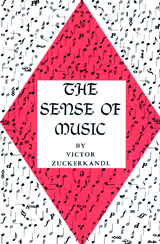Another Example of a Change of Tonal Center
In Example of a Key Change I gave an example of how the key or tonal center of a piece of music can change. Here is another example of a change of tonal center:
 |
| Victor Zuckerkandl's The Sense of Music |
The piece starts out in the key of G minor, with a key signature of two flats. The first six notes we hear, starting and ending on G, acquaint the ear with the fact that the tone G is the center.
One of these first six notes is F♯. As "raised 7," it actually belongs to the G minor scale of the piece. Minor scales often raise 7 and 6.
A key or tonal center change has somehow occurred by the end of the second phrase, at the fermata on a B♭ quarter note in measure 6. When that note is heard the ear interprets it, rather than G, as 1. The tonal center has moved!
In this case, the movement of tonal center does not happen as the result of playing a chromatic note that lies outside the expected minor-scale diatonic order of seven notes (or eight or nine, depending on whether minor-scale steps 7 and 6 are being raised).
What does usher in the new tonal center or key?
Zuckerkandl explains it as being the result of a move away from, rather than bang onto, the established tonal center of G: the first musical phrase ends in measure 3 on a fermata at degree 2 of the scale, A. When, instead of sounding a G, the next tones to be heard move away from that established center, the ear suspects the original tonal center of losing its grip.
When the second phrase ignores G entirely and winds up on B♭, after having flitted around that note and actually touched it three times, the ear simply switches its allegiance from G to B♭.
How can this happen without passing through a single chromatic tone that lies outside the original G minor scale (including its raised 7th degree)?
In the previous example, after all, it was the introduction of a new chromatic tone than signaled the new key. Here, all the notes in the scale of B♭ major are precisely the same as those in G minor, and the two keys accordingly have the same key signature.
The answer is that G minor and B♭ major are relatives. G minor is the relative minor of B♭ major. B♭ major is the relative major of G minor. These are just alternate ways of saying that B♭ major and G minor are two keys that have their scales composed of the same seven tones. The only difference, other than that one is major and the other is minor, is that in the former, B♭ is heard as the tonal center, while in the latter, the tonal center is G.
This hymn tune simply takes advantage of the close relationship that exists between relatives to loosen the grip of the original minor-key tonal center, G, and replace it temporarily with the relative major's tonal center, B♭.
The shift is temporary, due to the fact that the very next phrase, beginning with the last note in measure 6, hastily abandons B♭! Instead of reaffirming that note as the tonal center, the phrase ends at a fermata on an emphatic D.
D is 5 of the original key of G minor. Once it has been arrived at so conspicuously, D is immediately played again, an octave higher, as the lead-off note of the ensuing phrase, thus launching a cadence back to G as the final note of the piece.
By the time that final note arrives, the ear has been properly prepared, by this steady descent from 5 downward toward what it presumes to be the tonal center, to interpret G as 1 again!


